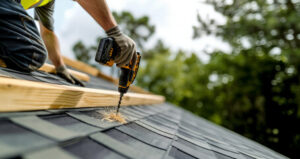If your roof is out of warranty or you notice recurring leaks, you may want to consider a complete roof replacement. While repairs can fix a few isolated problems, a new roof can protect the structure and improve energy efficiency.

A qualified roofing company like Ellingson Roofing LLC can perform an inspection to determine whether re-roofing is the best option for you.
A new roof can be a costly investment for property owners, but it can also provide significant tax benefits. It’s important to keep accurate records of any expenses related to roofing to qualify for tax deductions and credits.
Generally, the cost of a roof is divided into two categories: material and labor. About 40% to 50% of the total cost of a roof is for materials, and up to 60% of the total price tag goes toward labor. The rest of the money is for additional costs like building supplies, tools and other equipment. Some costs may vary depending on the size of your home and its location. The slope of your roof is a factor as well; steeper roofs will take longer to install and may require special equipment.
In addition to the actual cost of a new roof, there are also additional expenses like permitting and disposal fees. Some local governments charge a small fee to cover the cost of garbage pickup and handling the disposal of old roofing materials. Additionally, if you plan on adding any features to your roof such as skylights, dormer windows or chimneys, these can add to the overall cost of your project.
Minor repairs, such as replacing damaged shingles or fixing minor leaks, are usually the least expensive part of a roof replacement project. These types of repairs should be made as soon as possible to avoid worse problems down the line. Major repairs, on the other hand, are more complex and often require professional assistance. Typically, they are more expensive than minor repairs and can be as much as $8,000.
It’s worth noting that many homeowners will choose to replace their roof rather than repair it when the damage is severe enough. This decision is usually based on several factors, including the age of the roof and the extent of the damage. It’s important to understand the pros and cons of each option so you can make a decision that aligns with your practical and financial needs.
Investing in a new roof is an excellent way to improve your home’s value and protect its investment. It’s also a great way to save on energy bills and boost your curb appeal, making it a worthwhile investment for homeowners and investors alike.
Materials
There are a variety of materials that can be used for roof replacement. Some are more affordable than others, and each type has its own advantages and disadvantages. Typically, the size of your roof and the material you choose will have a major impact on the cost of your project. In addition, if your roof requires new gutters or insulation, these additional expenses may also be included in the total cost of your project.
The most popular roofing material is asphalt shingles, which are inexpensive and lightweight. They come in a range of styles and colors, from basic three-tab shingles to 30-year or 50-year premium architectural shingles. Other types of shingles include wood shakes, slate, clay tiles and metal. Before choosing a specific roofing material, consider the existing structure and its climate.
Proper ventilation and insulation are also important for a healthy home. They can reduce the amount of heat gained in the house and save on energy costs. While they are not part of the roof replacement process, it is a good time to evaluate and address these issues.
Depending on the size and complexity of your roof, you may need to hire professionals to install your new roof. This can increase the cost of the project and may require special equipment. Also, cleaning up and disposing of the old materials can add to the overall price of the project.
You should also consider the cost of any necessary roofing materials, such as a hammer, nails and a utility knife. A nail gun is useful for large roofing projects and can speed up the work considerably. A chalk line is also a handy tool for creating straight marks on the rooftop so that your shingles are placed in a symmetrical way.
Some types of roofing material are more expensive than others, but they usually offer a longer lifespan and higher durability. For example, a metal roof is a more durable option that can last up to 50 years and resists damage from hail and other debris. It can also help to improve your home’s energy efficiency by reflecting sunlight.
Installation
If you’re going to replace your roof, it makes sense to choose quality materials that will last a long time. The right materials will help keep your home cooler in the summer and warmer in the winter. They’ll also protect your interior from rain, snow, and hail. You can even choose a roofing material that adds style and character to your house. Some of these materials, such as slate, wood shakes, and metal, can cost more upfront, but they’ll last much longer than asphalt shingles.
The installation process can be a complicated one, but your roofers will take great care to make sure the job is done correctly. The first thing they will do is set up a safe work site by moving items that could get damaged during the tear-off process. Next, they will start the process of removing the old materials and clean up the debris. They’ll then begin installing the new materials.
A roof replacement involves laying many layers of different materials on top of the existing structure. The first layer is a felt or breathable synthetic underlayment that prevents moisture from penetrating the sheathing underneath. After that, a layer of shingle sheathing is installed. It’s usually 1/2” plywood, but it can be other types of sheathing depending on the type of roof.
Once the sheathing is in place, the crew can install metal flashing around chimneys and projections, and in valleys. They may also install ridge vents on the top of the roof, which can be very effective at cooling your attic space and preventing ice dams in the winter.
The shingles themselves are laid in rows, starting at the bottom and working upward. Depending on the kind of shingles you have, they will be nailed or tacked in place. A final layer of shingle sheathing is then installed, along with ice guard and ice dam protection if needed. Finally, a drip edge is installed on the edges of your roof to keep water away from your house. Your contractor should also inspect the sheathing to make sure it’s in good condition and to make any necessary repairs.
Warranty
When deciding to install a new roof, you should find out what the manufacturer offers in terms of warranties. This can help you decide if you want to go with a new roofing system that is backed by a full warranty from the manufacturer or if you prefer a contractor-backed workmanship warranty. The warranty will protect you from unexpected problems after the installation is completed.
The types of roof warranties vary, but most are divided into two categories: material and workmanship. The material warranty covers issues that stem from the actual materials used on the roof, while the workmanship warranty addresses issues related to installation. The length of each type of warranty varies. Some manufacturers also offer additional warranties, such as wind warranties and algae warranties.
Most standard manufacturer warranties last between 25 and 50 years, and they typically cover only manufacturing defects. If you’re looking for an extended manufacturer warranty, you’ll likely have to pay more and meet specific requirements to qualify for it. For example, an extended manufacturer warranty may only be available to homeowners who work with a qualified installer and register their products with the manufacturer.
Roof replacement is a costly endeavor, but it’s worth it to know that your investment will be protected in case something goes wrong. However, it’s important to understand what a roof warranty covers and how to maintain your roof in order to keep it in good condition.
A roof warranty is an insurance policy on your home’s most valuable asset. But like any other insurance policy, there are limits and exclusions that you should familiarize yourself with before committing to it. These can include things such as the definition of a “limited lifetime warranty,” which is subjective to each manufacturer’s context and intentions.
One of the most common reasons a roof replacement warranty is voided is because of a lack of maintenance. This can include things like routine inspections and cleaning that should be outlined in the warranty. It’s also important to stay with the same roofing contractor so that they can keep up with the proper maintenance of your roof. This can prevent minor issues from becoming major repairs and ensure the longevity of your roof.


